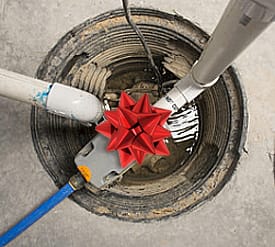Sunday, December 11th, 2016
‘Tis the Season for Wet Basements

When fall and winter dampness creeps into our basement area, I’m reminded of a scent forever etched in my childhood memories — the cool, mildew-y smell of my grandmother’s basement. To 10-year-old me, that smell meant a treasure trove of 1930’s Americana; an old, unlockable antique safe large enough to hold a small child; a cement floor that was crumbling under years of constant dampness, and a wringer washer she used well into the 1980’s.
Grown-up me wonders why none of grandma’s 7 children ever took the time to install a sump pump and make her dreary basement a dry and pleasant laundry area.
How does a sump pump work?
According to HowItWorks.com, “a sump pump usually stands in a sump pit — a hole with a gravel base about 2 feet (60 centimeters) deep and 18 inches (45 centimeters) wide — dug in the lowest part of your basement or crawlspace. As the pit fills with water, the pump turns on [and] moves the water out of the pit…away from your home to a spot where the water can drain away from [the] foundation.”
What are the downsides to a sump pump?
Sump pumps for home use require electricity, so in the event of an extended power outage, you may be at risk for water in the basement. Additionally, because the pump is in a wet area, a ground fault circuit interrupter (GFCI) is a must-have.
How will a sump pump affect my basement décor?
Given the choice of a damp (or flooded basement) or a small sump pump, it seems worthwhile to go with the sump. HowItWorks.com notes that “there are two primary sump pump designs, both of which are about 2 1/2 to 3 feet (76.2 to 91 centimeters) high. A submersible pump rests in the water,… in a waterproof housing, with the pump itself at the bottom and the outlet pipe near the top. A flat screen or grate covers the bottom of the pump to keep out debris. When the pump turns on, water is sucked up through the grate and routed into the pipes and out of your home.
The other common type of sump pump is the pedestal pump. Pedestal pumps look something like a long stick with a fat head. The pedestal keeps the pump out of the pit, away from the water even when the pit is full. An inlet pipe reaches down into the bottom of the pit to draw the water out. Becaue the motor and pump are out of the water, pedestal pumps are usually louder — but less expensive — than submersible pumps.”
A reputable plumber can help you determine which type of pump best suits your needs, budget and wet basement situation. The determining factors may include:
• Manual or automatic: Manually operated sump pumps are available but automatic pumps are hard to beat for convenience.
• Size: Sump pumps are commonly one-quarter to one-third horsepower. The size of the motor should be based on the amount of water you need to mitigate.
• Head pressure: Head pressure is the height a pump can raise water; your pump must be able to lift water out of the sump pit and up to the outlet pipe.
• Cord length: Pumps need to be plugged into a ground fault circuit interrupter (GFCI) outlet, without the use of an extension cord.
• Voltage: Standard 110-volt circuits for home use; 220 volt models are available for industrial applications.
Water You Waiting For?
If you’re considering sprucing up your basement (or your grandma’s), Allied Reddi-Rooter has extensive experience in sizing, installing, and maintaining sump pumps. Call, or Contact Ray today for a free quote and over-the-phone analysis of your needs (residential or commercial). Coupons. (513) 396-5300. We always come highly recommended and have earned an A+ rating from the Better Business Bureau for our expert quality of service.
